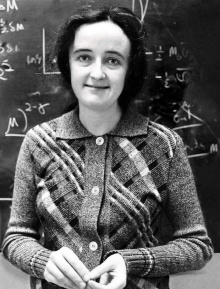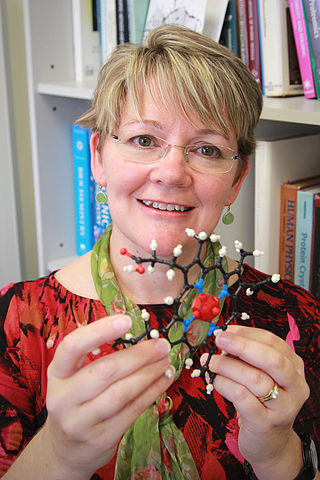Related Research Articles

Victoria University of Wellington is a public research university in Wellington, New Zealand. It was established in 1897 by Act of Parliament, and was a constituent college of the University of New Zealand.

Beatrice Muriel Hill Tinsley was a British-born New Zealand astronomer and cosmologist, and the first female professor of astronomy at Yale University, whose research made fundamental contributions to the astronomical understanding of how galaxies evolve, grow and die.

Mary Lowe Good was an American inorganic chemist who worked academically, in industrial research and in government. Good contributed to the understanding of catalysts such as ruthenium which activate or speed up chemical reactions.
Martin Gerhardt Banwell, Hon.FRSNZ is an organic chemist specialising in biotransformations and natural product synthesis.

JoAnne Stubbe is an American chemist best known for her work on ribonucleotide reductases, for which she was awarded the National Medal of Science in 2009. In 2017, she retired as a Professor of Chemistry and Biology at the Massachusetts Institute of Technology.

Rodney Graham Downey is a New Zealand and Australian mathematician and computer scientist, an emeritus professor in the School of Mathematics and Statistics at Victoria University of Wellington in New Zealand. He is known for his work in mathematical logic and computational complexity theory, and in particular for founding the field of parameterised complexity together with Michael Fellows.

Robert John Ferrier FRSNZ, FNZIC, was an organic chemist who discovered two chemical reactions, the Ferrier rearrangement and the Ferrier carbocyclization. Originally from Edinburgh, he moved to Wellington, New Zealand, in 1970.

Professor Jennifer Louise "Jenny" Martin is an Australian scientist, academic, and was recently the Deputy Vice-Chancellor at the University of Wollongong, in New South Wales. She is a former Director of the Griffith Institute for Drug Discovery at Griffith University. and a former Australian Research Council Laureate Fellow at the Institute for Molecular Bioscience, University of Queensland. Her research expertise lies in the areas of structural biology, protein crystallography, protein interactions and their applications in drug design and discovery.
Martina Heide Stenzel is a Professor in the Department of Chemistry at the University of New South Wales (UNSW). She is also a Royal Australian Chemical Institute (RACI) University Ambassador. She became editor for the Australian Journal of Chemistry in 2008 and has served as Scientific Editor and as of 2021, as Editorial Board Chair of RSC Materials Horizons.
Peter Bernard David de la Mare was a New Zealand physical organic chemist.
Margaret Harding is an Australian chemist and educator who is currently Deputy Vice-Chancellor (Research) at The Australian National University (ANU). She is an expert in medicinal and biomolecular chemistry, with special research interests in the areas of antifreeze proteins and ligand-DNA interactions.

Margaret Mary Sheil is an Australian academic and the Vice Chancellor and President of Queensland University of Technology.

Ganapati Dadasaheb Yadav is an Indian chemical engineer, inventor and academic, known for his research on nanomaterials, gas absorption with chemical reaction and phase transfer catalysis. He served as the vice chancellor of the Institute of Chemical Technology, Mumbai from 2009 until November 2019. He is currently the Emeritus Professor of Eminence at ICT Mumbai.
Chunni Lal Khetrapal was an Indian chemical physicist and a vice chancellor of Allahabad University. He was known for his studies in chemical physics, particularly in the field of Nuclear magnetic resonance spectroscopy. He was an elected fellow of the Indian National Science Academy and the National Academy of Sciences, India. The Council of Scientific and Industrial Research, the apex agency of the Government of India for scientific research, awarded him the Shanti Swarup Bhatnagar Prize for Science and Technology, one of the highest Indian science awards, in 1982, for his contributions to chemical sciences.
Narayanan Chandrakumar is an Indian chemical physicist and a professor of chemistry at the Indian Institute of Technology, Madras. He is the founder of the first Nuclear magnetic resonance (NMR) laboratory in India and is known for developing a new technique for NMR imaging and diffusion measurements. He is an elected fellow of the Indian National Science Academy and the Indian Academy of Sciences The Council of Scientific and Industrial Research, the apex agency of the Government of India for scientific research, awarded him the Shanti Swarup Bhatnagar Prize for Science and Technology, one of the highest Indian science awards, in 1996, for his contributions to chemical sciences.
Ganesh Prasad Pandey is an Indian organic chemist and scientist at National Chemical Laboratory. He is known for his researches on photo-induced single electron transfer reactions and the synthesis of natural products and is an elected fellow of the Indian National Science Academy the National Academy of Sciences, India and the Indian Academy of Sciences The Council of Scientific and Industrial Research, the apex agency of the Government of India for scientific research, awarded him the Shanti Swarup Bhatnagar Prize for Science and Technology, one of the highest Indian science awards, in 1999, for his contributions to chemical sciences.
Subramania Ranganathan (1934–2016), popularly known as Ranga, was an Indian bioorganic chemist and professor and head of the department of chemistry at the Indian Institute of Technology, Kanpur. He was known for his studies on synthetic and mechanistic organic chemistry and was an elected fellow Indian National Science Academy, National Academy of Sciences, India and the Indian Academy of Sciences The Council of Scientific and Industrial Research, the apex agency of the Government of India for scientific research, awarded him the Shanti Swarup Bhatnagar Prize for Science and Technology, one of the highest Indian science awards, in 1977, for his contributions to chemical sciences.
Elizabeth Joy New is an Australian chemist and Professor of the School of Chemistry, University of Sydney. She won the 2018 Australian Museum 3M Eureka Prize.
Brian Halton was a New Zealand organic chemist. He is noted for his investigation of highly strained and fused aromatic compounds, and was also active as an historian of chemistry.

Margaret Mary Hyland is a Canadian-born chemist based in New Zealand whose research focuses on aluminium technology, and the chemistry and engineering of material surfaces. She moved to New Zealand in 1989 and after holding many senior academic leadership roles supporting and developing research at the faculty, university and national level became recognised as an authority on the generation and capture of fluoride emissions from aluminium smelters and for coordinating the team that produced the 'Fluoride Emissions Management Guide' for the aluminium industry. This achievement was acknowledged when she became the first woman to win the Pickering Medal. In 2017, Hyland was seconded to the Ministry of Business, Innovation and Employment in the role of Chief Scientist and has held positions in a variety of other groups supporting the physical sciences and engineering. Since 2018 she has been Vice-Provost, (Research) at Victoria University of Wellington, New Zealand.
References
- ↑ "Kate McGrath". profiles.uts.edu.au. Retrieved 14 October 2021.
- 1 2 3 "Professor Kathryn McGrath". Science Learning Hub. Retrieved 14 October 2021.
- 1 2 "Kate McGrath | Return On Science". www.returnonscience.co.nz. Retrieved 14 October 2021.
- ↑ "Postgraduate prospective 2014" (PDF). Victoria University of Wellington. p. 29. Retrieved 27 October 2023.